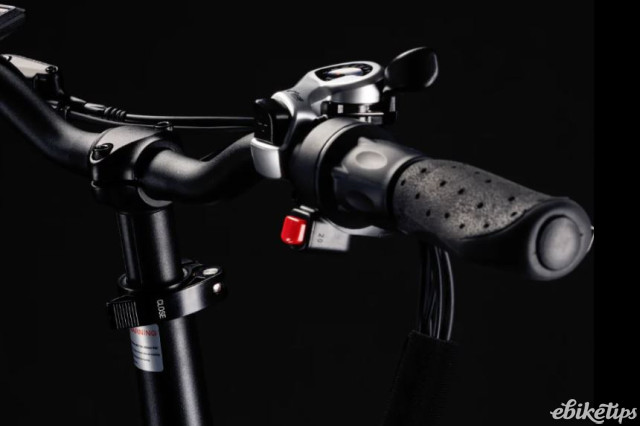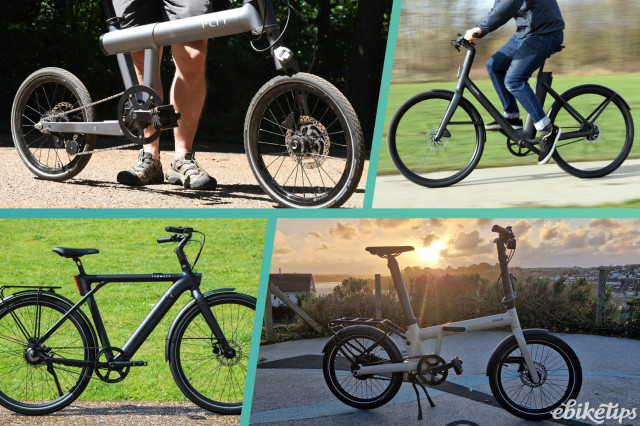Review: WAU Bike

Overview
- Rear brake lights strong and useful
- Large capacity battery
- Rear indicating lights only
- Pricey for the components used
WAU is a UK start-up, and their eponymous single-sized model has some striking design elements that perhaps point the way to the future of e-bikes; namely hard-wired indicators and an inbuilt GPS locator, plus an anti-tamper alarm. While none of these elements are totally unique, it is quite unusual to see them altogether on an e-bike. If e-bike manufacturers want to tempt those wedded to their sleek, technology-packed BMWs and Audis out of them and onto e-bikes, the WAU Bike has the kind of technology that might help.
Buy the Wau bike here
The WAU bike is a conventional design based around a one-size-fits-all diamond frame with a geared rear hub motor. I measured the frame at 19”, suggesting smaller or much larger riders might struggle to ride it comfortably. The total weight was 28.1kg (including the 4.3kg battery), probably about par for the course for an e-bike with a battery this size. Prices start from £1,897 with current earlybird offers, going up to the price of our test bike with the larger battery option (there's also free shipping for all UK customers).
Most noticeably, the seat stays incorporate elongated LED strip lighting with four functions: red night time lighting, super-bright brake lights, softer ‘ghost lighting’ that comes on automatically according to a built-in light sensor, and indicator lights.
There’s a bikepacking-style central housing in the middle of the diamond frame - but made of ABS plastic rather than material of course - and bolted onto the frame. This houses the battery (an impressively large 886Wh on my test bike), GPS tracking unit and, in a separate sealed compartment at the front, alarm and control unit.
The Shimano Acera 8 speed gearing is near the bottom end of the Shimano’s derailleur range, but perfectly functional. It’s much better on an urban e-bike like the WAU to put money into things like hydraulic disc brakes; and indeed, aero profile 700c rims are stopped by Tektro hydraulic discs.
The semi-slick Vee Tires are 42mm wide, and fine for both road and gentle riding on unsurfaced paths and tracks. The handlebar stem is adjustable with an allen key to give a choice of riding positions, from comfortable through to low and sporty.
There is a strong front LED light, though disappointingly that is powered by its own batteries independent of the main e-bike battery, and doesn’t feature indicators. The kickstand is reasonably sturdy, and you can fit mudguards and a rear rack if needed.
The C3-branded battery removes for charging; you need to unlock both locks from the battery case, and it simply unplugs and pulls out as it’s effectively a friction fit.
My overall impression is that this design tries to incorporate some novel and useful features, but just falls a little short on the execution and quality front; for example, there are exposed wire runs where you can see the thin core wires as they enter the seat stays to power the rear lighting.
The rear hub motor is geared more for maintaining good speed over moderate hills, and the quiet hum became more of a groan up larger gradients on my test ride. It also likes a good fast cadence to keep the motor spinning along. The 48t front chainring and 11-32t rear sprocket give a 295% gear range (40-118 gear inches). In the hilly Pennine country I tested it in, I felt the range could be moved down somewhat to aid steep hill climbing with appropriate changes to the chainring or sprockets.
The WAU Bike uses a conventional cadence-sensing system with the tell-tale sensor found around the base of the crank. There was quite a bit of run-on once pedalling stops, meaning you have to have the brakes covered pretty much all the time. My test bike didn’t have the throttle option so I’m not sure how this would work, but it might transform the bike into a different and much better machine (throttles are allowed on e-bikes but the pedals must be turning for them to be activated), allowing the rider to apply power more accurately just where and when it was needed.
Following cyclists confirmed the brake lights were definitely bright enough, and their application was a clear signal that the rider was slowing. The rear indicators were similarly clear, apart from in very bright sunlight when they were too faint to be clearly noticed. If the indicator power could be increased and a similar system applied to the handlebars, this would be one of the best bike indicating systems out there. A flashing light on the indicator switch would have been useful, so you don’t leave them on accidentally. The white illuminated lettering on the side of the battery casing is also a welcome safety feature.
It’s difficult to see how using a rack with panniers wouldn’t obscure the rear lights, but WAU say they have an aftermarket rack on offer that means the lights are still visible, and will also let you fit and extra battery.
The wide semi-slick tyres and front coil-sprung suspension suggest the bike is suitable for those who might want to venture off-road on towpaths and forest tracks. I found as soon as the bike encountered bumpy ground there was a knocking sound from the battery case – either the battery moving around inside the case or the cells inside the battery – neither of which is very satisfactory. Ditching the front suspension for a lighter, solid fork and marketing it as a road hybrid would perhaps have been a wiser move.
The colour display option on my bike was nice and visible and gives speed, odometer, tripometer and trip time. There is also a handy USB charging port for keeping your devices topped up. You can opt for a cheaper LCD ‘black and white’ option; that would most likely do the same thing, but won’t look as flashy.
The WAU comes with an alarm that can be set with buttons on the key fob, and it works pretty well. Once activated any disturbance of the bike gives an initial sonic warning, and if it’s moved again increasingly disturbing sounds are emitted that would no doubt deter a casual thief. It would be nice to see these sounds last longer than the 15 seconds or so I timed them at, and also I’d want them to be louder so as to deter more persistent offenders; after all, the WAU is a very eye-catching bike that will attract plenty of attention.
Unfortunately I couldn’t get the WanWay GPS tracking system to function correctly, but when working it should provide tracking if the bike is stolen. You would also notifications to your phone if the bike is taken outside a certain area pre-defined by the user; known as ‘geofencing’. The GPS unit itself is easily accessible inside the battery case; clearly not ideal in the case of theft.
Some aspects of the WAU Bike’s design are encouraging; it seems a genuine attempt to develop an interesting new e-bike design for urban riders, who want a long range battery and useful features like indicators and brake lights... well, in the author’s opinion these features are useful, but other cyclists might not rate the importance of developing things like indicating technology. It also includes security features that could encourage people to make a significant investment in an e-bike with all mod-cons. It’s just a pity the design logic isn’t followed through completely, and the build standard isn’t better in some areas.
It would be nice to try out the next version of the WAU - perhaps with a punchier motor for hill climbing with the electrical lighting and tracking aspects up to speed - as it feels like there’s an interesting and useful bike in here trying to get out.
2 comments
Looks like a delivery boy's bike to me.
Looks and sounds like a parts bin prototype to me.














